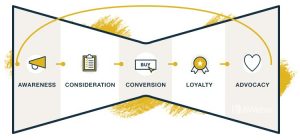The Marketing Funnel is a system that triggers demand of a product by tracking the stages consumers go through before making final purchase. The various stages of buyer behavior are need, search, evaluation, and choice/purchase and post purchase evaluation. While the customer goes through these five stages right from feel of need till post purchase euphoria or post purchase blue (customer can either feel happy or gloomy after a purchase) the marketing funnel keeps working by activating the need of the customer mor e and more.
e and more.
According to the old-school of thought, the marketing funnel appeared like this: in this funnel the marketer required to fill the top of the funnel with as many leads (prospective customers) as possible since the bottom of funnel only filters out a small percentage of concluding customers.
But today, a majority of business firms understand that their relationship with the customer should not end at the bottom of the cone-shaped marketing funnel. Instead, it should open up the funnel after a person purchases a firm’s product. Firms today invest on retraining the customer forever. Firms try to capture the customer’s journey after a person buys product of the firm. At its core, customer relationship management (CRM) is all of the activities, strategies and technologies that companies use to manage their connections with their current and potential customers. The proverb “customer is king/queen” is literally practiced through the marketing funnel; therefore today’s funnel looks like this.
Role of CRM: Customer Relationship Management helps firms to build association with their customers. CRM helps firms to create loyalty and customer continuation. Customer’s experience with a firm increases their loyalty towards it. Product quality and loyalty goes hand in hand and increasing the sales of a firm. CRM is a management strategy that results in increased profits for a business. At its core, a CRM as a tool creates a simple user-related collection of data that helps businesses recognize and communicate with customers in a quantifiable way.
A far-sighted business firm therefore needs to adopt various strategies to influence consumers at each stage of the funnel. Stages such as awareness, comprehension, conviction, action can be geared by follow-up telephone calls, sending them positive press reviews, reminders, or updated corporate communication. The sales and marketing departments must guide this traffic of the prospective customers through the funnel using strategies that are designed to be effective at each stage. At each stage of the corporate communication, firms need to update it with latest trends.
Role of Social Media: A marketing funnel starts with awareness. Please understand this fact that a firm cannot do anything until consumers become aware of the existence of their brand. Social media gives business marketers a direction to communicate with customers, and to find specific potential consumers. It personalizes the “brand” and helps business to spread the firm’s message in a comfortable and informal way. It helps in creating awareness and harnessing the power of word-of-mouth, which is much more effective than traditional advertising.
Effective marketing strategies a must in each funnel stage: marketing activities must be conducted in such a way that they must facilitate consumers through the funnel process. The activities must engage promotional activities to create awareness about the products, detail of the benefits compared with the competitor’s product, chart the advantages of how a purchase will benefit the customer, or offer a special promotion that infuses the sale. Once the sale is complete, marketers needs to engage the customer to get feedback and retain loyalty, as that can lead to repeat business and referrals.
Marketing and sales funnel is one and the same: Some companies differentiate between a marketing funnel and a sales funnel, but both can work together seamlessly. The distinction in both is immaterial. Marketing is responsible for generating traffic at the top and through the middle of the funnel, and as these leads or buyer prospects get closer to a decision, the sales activity clicks.
Marketing funnel is based on technology: Digital technology is part and parcel of business and cannot be ignored by marketers. The marketing funnel offers a good example of this fact. The buying process has become faster than before. Majority buyers do their own research online, comparing features and benefits of competitive products, rather than relying on a company’s traditional marketing activities to guide them through the funnel stages. This means buyers enter the funnel at a point where they are more prepared to make a sale. It also means companies need to get information online; they need to upgrade their website, blogs with product content, price, discounts, warranty, guaranty etc, etc. Post purchase review has become an essential feature these days.
Funneling is a continuous non-stop process: No company can ever say that they have completed marketing activity. The world is changing fast. So does the customers’ needs, wants and demands. The competition is fierce in every walk of life. There is nothing called product loyalty in business world. Continuous improvement in marketing helps firms to achieve better returns on their investment in marketing. Continuous improvement is a form of quality management that focuses on making small additional improvements to a process, rather than trying to achieve major changes. In marketing, at each stage of funneling, firms can keep doing continuous improvement to achieve goals such as increasing the accuracy in segmenting, targeting and positioning of course by using product differentiation strategy.
The marketing funnel is visualization and perceptive to understand the process of turning leads (prospective customers) into real customers. The idea is that, like a funnel, marketers cast a broad net to capture as many leads as possible, and then slowly nurture prospective customers through the purchasing decision, narrowing down these customers in each stage of the funnel.
The funnel is a term for describing the route by which prospective customers, or prospects, become customers. The visualization of the process looks like a funnel. A larger number of prospects go in the top and are reduced to a lesser number of customers who come out at the bottom.













































